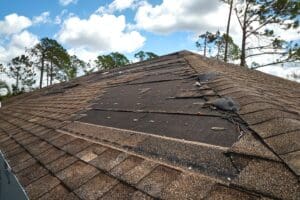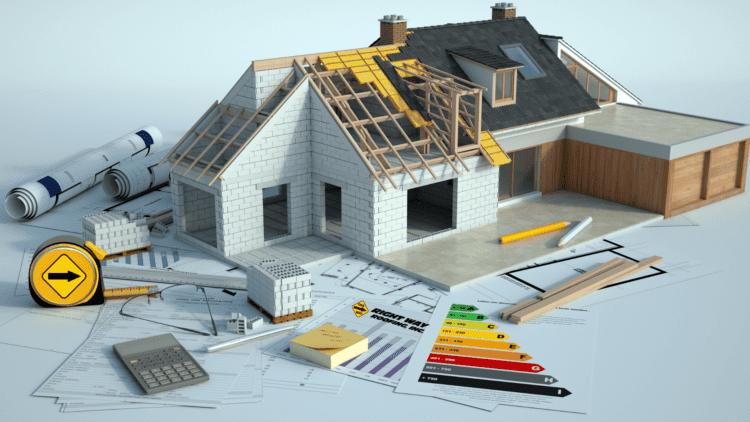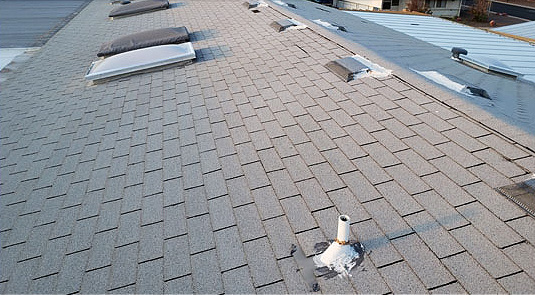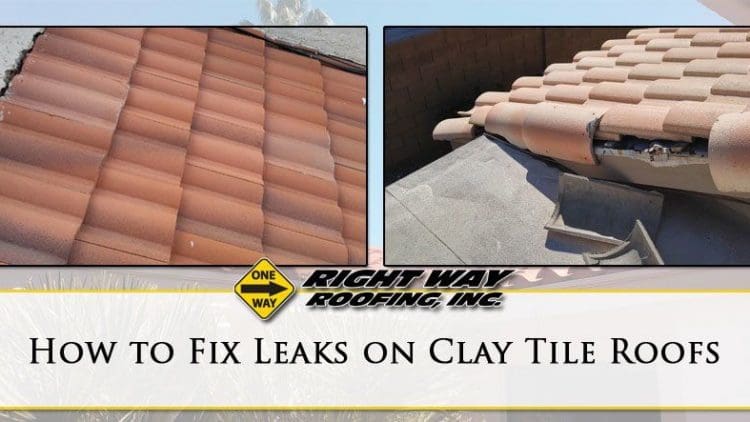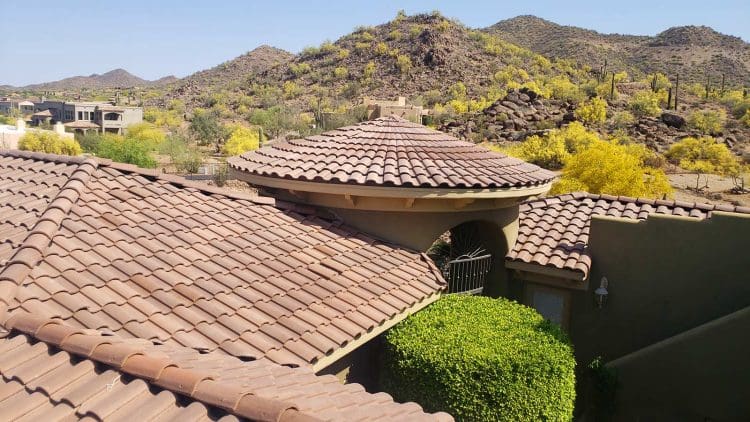If you’re searching for how to fix leaks on clay tile roofs you’ve likely got a problem on your hands. Water coming through your roof can lead to damaged insulation, ruined ceilings, and needing to replace sheetrock, carpet, and much more. Clay roof tile can be susceptible to leaks which are caused by various problems with the installation methods, tile itself, and age. The way that the leak can be repaired will differ based on the cause of the issue.
How To Repair A Tile Roof
Tile roofing is durable and adds great curb appeal to your home. All roofing will need some maintenance and repairs at some point. The following steps show you how to repair a tile roof. Should you not have the tools or time our team is always ready to help you repair your tile roof anywhere in the Phoenix Valley.
Tools and Materials
Keep in mind that the tools and materials that are needed will depend on the cause of the leak.
- Nails
- Wet saw
- Hanger strap
- Pry bar
- Hammer
- RT-600 Tile Roof Sealer in Terracotta color
- Caulk gun
- Waterproof membrane
- Mortar
Step 1: Identify The Cause
Clay tiles may leak because of several reasons. While some issues will go beyond your roof and will be related to other things to do with roofing or the installation methods, some of the common issues with clay tiles are:
- Broken tiles
- Cracked tiles
- Collection of debris on the roof valley
- Worn out or defective waterproof membrane
In order to fix the leak, you will have to fix the issue that applies to you. Keep in mind that the clay roof tiles will break easily under pressure, so be sure to be careful whenever you are walking on your roof to find the cause of the leak.
Step 2: Fixing the Membrane
If the issue is in the waterproof membrane, then you will have to remove the existing tiles and replace the membrane with a new one. Then you will have to retile your roof. You may need the help of a professional for the removal and re-tiling.
Step 3. Removing the Debris
The roof valleys, especially closed ones will collect a lot of debris. This can cause leaks. To remove the debris, so there is no more leaking, you will have to remove the tiles from the area, then clean the area out, and lastly reinstall the tiles. You may consider wanting to covertyour roof valleys to be open to help to avoid any collection of debris within the future.
Step 4. Fixing cracks
If you happen to notice any fine cracks within the tiles, then you may repair them by applying RT-600 on the cracked tiles and then allow it to spread on the whole tile and let it dry.
Step 5. Fixing broken tiles
Tiles that have large cracks or are broken will need to be replaced in order to fix the leak. You will need to remove the damaged tiles using a pry bar. Use a hammer to help with the removal, but be careful to make sure that you will not damage the good tiles. If the roof is old, then the chances are that the tiles have been fixed using mortar. If this is the case, place the new tiles and use mortar to seal them in place.
More current rooftops will have nails that will hold the tiles set up. On the off chance that that is the situation, you will require a holder lash. Place the new tile on the holder lash, and after that hang it where the new tile will need to be fitted. Ensure that you don’t force the tile in place. Use a wet saw to cut the edges, if it is needed. Next, hammer the nails into the top of the tiles, which will secure the new tile to the roof. Apply mortar or RT-600 to the sides to make sure that there is a complete seal.
How to Repair Leaking Concrete Tile Roofs
Even though it may be installed correctly, a concrete tile roof will normally be durable enough to be enough for your home, but this doesn’t always stop the issues that can come up if it is hit by a tree branch or bad weather. By following the require steps, you will find that it is quite easy to replace any leaking tile.
Step 1. Inspect the Roof
You will start the repair process by examining the roof tiles to find just how bad the damage is. This will let you know how many tiles need to be replaced. Even though you may be able to see the damaged tiles from the ground, a proper inspection needs to be done so that you can see the tiles up close. When you do this, you can make sure that you don’t miss any tiles that are cracked and appear that nothing is wrong with them.
You may not be able to access the roof from the attic, you could get an idea about how bad the damage is by checking the roof in the attic.
Step 2. Gather your Equipment
Once you know how many tiles are needed, you can make sure that you get plenty of replacements. If needed, remove the cracked or broken tiles from the roof and take it with you when you purchase new ones. Gather all the tools and equipment that you will need to do the job, including shoes that have the right soles that will let you move around without slipping or breaking more tiles.
Step 3. Remove the Damaged Tiles
Make your way up the ladder with the tools and make your way to the leaking area of the roof. If multiple tiles need to be replaced, start at one end and then work your way across. You will want to identify the first tile to remove and then lift it carefully above just enough to allow a crowbar to slide beneath it. Give the length of the crowbar a chance to lay on it askew and to one side on the rooftop that is in place. You would then be able to lift the tile to one side of the one being expelled and keep it held up with the other. Then simply slide the tile out, although you may need to raise it up first to unhook it from the holding.
Step 4. Replacing the Tiles
To replace the tiles on the roof, reverse the procedure that you used to remove the tiles. Your crowbars should provide plenty of space to see the holdings and adjust them if needed. Otherwise, it will be easy to slide the tile into place. Once you are happy with the fit, hold onto the raised tiles and slide the first crowbar from where it was, while avoiding scratching the tiles, and do the same with the other crowbar. If broken tiles have caused damage to the flashing, then make sure you replace that too.
Repairing the Flashing for Clay Tile Roofs
Being able to know how to repair the flashing on your clay tile roof can save your home from a lot of water damage. The most common areas for flashing are in skylights, chimneys, ridges, roof penetrations and valleys and they are used to waterproof the roof. Flashing is the last defensive stop before water damage.
To effectively repair this, the flashing will need to be replaced. The roof and chimney are exposed to the elements and over time a lot of wear and tear happens. Climbing on the roof will save you money on a roofer. Make sure to be safe and invest in safety equipment before making that climb.
Step 1. Removing the Tiles
Put your gloves and using the slate ripped, remove the tiles around the flashing. To get access to these tiles, you may need to remove tiles around them.
Step 2. Cleaning Up
Once the tiles have been removed, there are things that can be found. Broken tiles, dirt, and debris will need to be picked up and removed. Be sure to remove the old flashing. There may be tar that was used with the old flashing and try to remove as much as possible. Because the flashing is metal, try not to get cut.
Step 3. Installing the Base Support
There will be a copper sheet metal flashing to be nailed down, which becomes a base support for the new flashing. It also helps to prevent sagging under the lower roof tile. Using the support, it is another layer that water will have to get through to reach your home.
Step 4. Installing New Flashing
Use copper nails to secure the flashing and hammer them to the roof deck. Be sure that sides are bent, and that it is both back and up as this stops water from flowing to the sides. The water will need to be sent away from areas where it can seep in. There are some homes that will have pipe on the roof along with the chimney. It is important to install flashing on the pipe as well. Use caulking to attach the flashing to the pipe and the new flashing needs to be taller than the pipe. Use straight cutting tin snips to cut the top just above the old pipe. Bend it into the top of the pipe as this helps to create a water tight seal.
Step 5. Replace the Roof Tiles
Trim and install the new tiles. The new clay roof tiles need to match the ones on the roof. Use nails to secure them. When replacing them, the tile needs to be laid down in the same direction and fashion. It is best to work from left to right.
Clay tiles are quite unique, as you will need to have extra care when handling them. Taking care of your roof is important, both for the interior and exterior of your home.
How to Repair a Concrete Tile Roof
A concrete tile rooftop is both stylishly lovely and exceptionally handy. It for the most part has a long time span of usability, however it can break because of extraordinary temperature conditions. In such a circumstance there is no other option than to repair or supplant the harmed tiles. Repairing a solid tile rooftop isn’t an unimaginable assignment. With the correct devices, this guide and taking the essential security insurances, you can carry out the activity yourself. Here’s the manner by which to repair a concrete tile rooftop.
Step 1. Safety First
Before you begin repairing your solid tile rooftop, ensure you have your cowhide gloves and defensive eye glasses on. Utilize the stepping stool to get on the rooftop. Ensure you chip away at the harmed tiles deliberately. While treading, you should be mindful so as not to harm different ranges on the solid tile rooftop.
Step 2. Replace the Tiles
The substitution tile ought to be a correct match to the current solid tile rooftop. You should can get your hands on the tile’s model number and producer subtle elements. Getting the correct kind of tile is of most extreme significance, as a solid tile rooftop takes after a specific example. Getting it from the first producer would be the most secure wagered.
Step 3. Use a Crowbar
Insert the crowbar under the damaged part of the concrete tile. Place it onto the left-hand tip of tile that is damaged.
Step 4. Removing Damaged Tiles
Remove the damaged tiles by applying slight pressure on the crowbar. This forces the tile up and you can remove it.
Step 5. Tiles Above the Damaged Tiles
Follow steps above to remove the tile directly over the one you just removed.
Step 6. Replacing the Tile
Remove and dispose of the damaged tile. Place a new one in the vacant spot and make sure it is fixed securely on the roof.
Step 7. Secure the Tiles
Most new tiles don’t need nails to hold them in place. Position the tile and align it and then snap it into place.
Step 8. Repeat
Repeat the process of snapping and fixing the tiles until they are all replaced.
Step 9. Finishing
Check again to make sure that all the tiles you replaced are in place firmly. That is all that needs to be done.
Clay Tile Roof Repair: Mistakes you should Avoid
Utilizing the correct techniques to finish aclay tile rooftop repair is an imperative part in ensuring you don’t cause more harm than you proposed to repair. Clay tile rooftops are additionally greatly delicate so it’s critical to take additional care when taking a shot at them. This and other normal errors are imperative to remember before handling your next repair.
Storing Materials Properly
When undertaking a clay tile rooftop repair one of the principal issues you will need to manage is the place to store the materials that are to be utilized as a part of the repair. Albeit brimming with noteworthy appeal and character these rooftops can’t bolster much weight on their surface. With a specific end goal to abstain from harming the great earth rooftop tiles you’ll need to spread the weight out to finish a bigger territory. It’s likewise a smart thought to abstain from stacking different groups one over the other. A decent general guideline is to stack close to two packages together. The best technique is to make an organizing territory on the ground and convey the material to the rooftop as it’s required. Be that as it may, this can’t generally be expert particularly when managing high rooftop lines.
Accessing the Roof
The delicate idea of mud tiles makes getting to the rooftop to play out your repair fairly a precarious suggestion. While putting the augmentation stepping stool against the eave of the rooftop is a smart thought to put assurance between the stepping stool and the rooftop. This will help avoid splitting or chipping any dirt tiles along the edge. Another smart thought is to put a defensive drop material, for example, an old cover, to work off of. Putting away your devices on the exposed mud tiles can cause extra chipping and splitting. Once on the rooftop you should wear non-slip shoes and walk gradually while dispersing your weight equitably. When walking, it’s additionally prescribed to abstain from venturing straightforwardly on the edge of a tile as these are the weakest focuses.
Removing the Old Tiles
When performing clay tile rooftop repair you’ll need to seclude the territory of repair so as not to harm any of the adjoining rooftop tiles. Clay tiles can be harmed by falling trees or simply break after a few periods of weathering. Much of the time, you’ll just need to supplant a couple of tiles to effectively entire the repair. Unpracticed roofers will frequently damage neighboring tiles while attempting to evacuate the damaged ones. To maintain a strategic distance from this situation, utilize a bit of wood to wedge the tile up. This will permit you access to expel the nail holding the harmed tile set up. When breaking separated the harmed tile utilize an etch in conjunction with a mallet. This will give you more control and keep any inadvertent blow-back to existing tiles. By maintaining a strategic distance from these regular slip-ups while expelling an old tile you can guarantee you don’t make more work for yourself.
Clay Tile Roof Leak Repair Service
If you don’t have the tools, time, or desire to fix your leaking clay tile roof, or any other kind of roof, Right Way Roofing, Inc. has you covered. Our family-owned and operated company has been repairing tile roofing in the Phoenix Valley for 3 generations. This means we’ve seen it all, and repaired it! We use the roofing materials for all of our roofing services from installation and maintenance to repair and replacement. Every visit from our team assures property owners in the Phoenix Valley of the very best roofing services.



